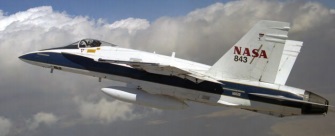Chapter: Flight and Ground Experimental Test Technologies, new invention technology, Research project papers,
Real-Time Parameter Identification

Real-Time
Parameter Identification
Armstrong researchers have implemented in the
control room a technique for estimating in real time the aerodynamic parameters
that describe the stability and control characteristics of an aircraft.
Typically, aerodynamic modeling is performed on recorded data after test
flights and then used in simulations. The drawback with this approach is that
if the collected data are not complete or of high quality, additional
and costly flight tests must be scheduled. In
this innovative approach, Armstrong's real-time parameter estimation automates
the process and runs during flight, enabling researchers in the control room to
evaluate and adjust flight maneuvers to ensure data quality. The technology
increases the efficiency and productivity of flight tests, as researchers can
determine during the tests if they have collected the data needed for specific
modeling simulations.
Work to date: The
technology is currently being used in Armstrong control rooms to
evaluate data collected during test flights as well as in-flight maneuvers.
Looking ahead: Researchers
are continuing to improve the system display and are working to
refine the way results are presented. A capability to compare the estimated
parameters to preflight-predicted values is being added, which will make it
possible to evaluate the aerodynamic effects of aircraft modifications.
Benefits
Automates data collection: Estimates
in real time the parameters for aircraft stability and control
Improves data
quality: Enables adjustments during flight tests to ensure
correct data acquisition
Saves time
and resources: Decreases the duration and number of flight tests
Applications
Aerodynamic modeling
Flight and Ground Experimental Test
Technologies
Armstrong conducts innovative flight research
that continues to expand its world-class capabilities, with special expertise
in research and testbed platforms, science platforms, and support aircraft.
Re-searchers place particular emphasis on providing accurate flight data for
research aimed at designing next-generation flight vehicles. Described here are
research projects that are seeking to increase safety, reduce costs, and
dramatically decrease testing and approval times. Armstrong's new verification
and validation (V&V) simulation test bench is particularly innovative as it
integrates reconfigurable software models for multiple aircraft components.
These models enable high-fidelity simulations to be performed more easily and
at significantly faster rates than are possible with hardware-centric test
benches.
Related Topics